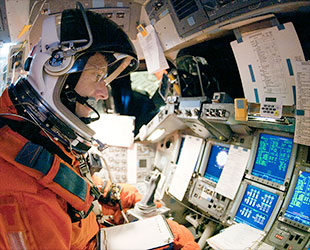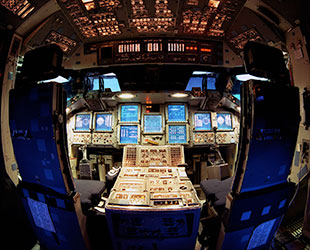August 3, 2016 — A space shuttle cockpit that was used to train all of the crews that launched on board the winged orbiters has landed in Oklahoma, where it will be displayed at a museum named for a veteran NASA astronaut.
The Stafford Air & Space Museum, located in Weatherford, Oklahoma, announced Wednesday (Aug. 3) its acquisition of the fixed-based simulator (FBS), a high-fidelity replica of the shuttle's flight deck and partial middeck, which was in use for three decades at NASA's Johnson Space Center in Houston.
"Each of the 135 astronaut crews to fly the space shuttle conducted a significant part of their primary training in the FBS," museum officials said in a release. "By acquiring an artifact of this significance, the Stafford Museum has taken a giant step towards its goal of becoming an institution of national importance."
In active use for training from before the first space shuttle launched in April 1981 through the end of the program in July 2011, the FBS was originally awarded by NASA to the Adler Planetarium in Chicago, where it was sent four years ago.

STS-135 commander Chris Ferguson trains to fly on the last space shuttle mission inside the fixed base simulator. (NASA) |
Although the Adler initially had plans to display the FBS, it remained crated in storage. Ultimately, the Adler found that its long-term plans did not include space for exhibiting the large simulator, with the exception of its food preparation galley and waste containment system, otherwise known as the shuttle's toilet, which remain at the Illinois planetarium.
The Stafford Air & Space Museum, named for Gemini and Apollo astronaut Thomas Stafford, received the FBS from the Adler, including its exact representation of the shuttle's flight deck equipped with more than 2,200 switches, circuit breakers, gauges, displays and dials. The museum intends to display the fixed base simulator partially powered, such that its backlit control panels and screens appear as they did when the FBS was last in use by the final space shuttle crew.
Perhaps as soon as the start of the new year, visitors to the Stafford Museum will be able to walk between the flight deck's forward and aft sections, providing a rare up-close look at a fully-authentic shuttle cockpit.
The FBS will become a major feature of the Stafford's new space shuttle gallery under development at the museum. The expanded exhibition hall will include hundreds of other artifacts from the 30-year program, including a flown space shuttle main engine nozzle, a flown segment from a solid rocket booster, an orbiter's partial tail assembly, fuel cells, spacesuits, a cargo bay pallet, experiment packages and hardware from the Hubble Space Telescope.

Fisheye view of the fully-powered forward flight deck in the shuttle fixed-base simulator when it was in use at NASA. (NASA) |
The cost to acquire and move the simulator from Chicago to Weatherford was underwritten by the Stafford Museum's foundation, which is financed, in part, through the support of members and donors.
Referred to as a "fixed base" simulator, the FBS was used in conjunction with a motion base simulator outfitted with a similar flight deck replica mounted on a hydraulic platform, so that it could approximate the orientation of the cockpit during flight. The motion base simulator was transferred to Texas A&M University in College Station at the same time the FBS was awarded to the Adler.
Though Thomas Stafford never flew on the shuttle — his final mission was as commander of the joint Russian-U.S. Apollo-Soyuz Test Project in 1975 — he continued to serve on NASA advisory panels throughout the shuttle program, including chairing the task force for the docking missions to Russia's Mir space station and co-chairing the Stafford-Covey Space Shuttle Return to Flight Task Group after the loss of the orbiter Columbia in 2003.
In addition to the space shuttle artifacts, the Stafford Air & Space Museum displays a Titan II rocket, full-size models of Gemini and Apollo spacecraft, an Apollo Saturn V F-1 rocket engine and the spacesuit that Stafford wore aboard the Apollo 10 mission to orbit the moon.
